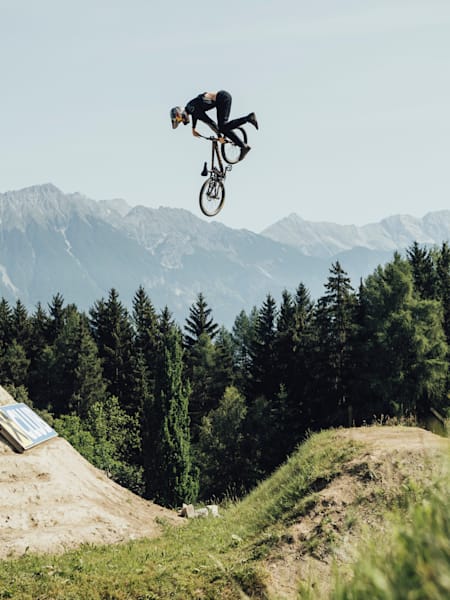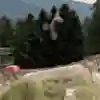
Hello Paul, to begin with, please tell us bit about yourself?
I started judging snowboarding in Whistler, British Columbia, around 1996. From there, I worked my way up to international events and also became a judging educator at the highest level. In Whistler, I was around a lot of events and once the first Crankworx came, they asked me to head judge it. I didn’t have much biking experience at that time but understood the tricks and difficulty of them. Not long after that I started biking myself and traded my snow boots in for mountain bike shoes. Today I live in Squamish and ride some of the best trails in the world.
What does your role as head judge entail?
A head judge has a good understanding of the sport, knows their trick difficulty and constantly watches for the execution of a trick. But also, at the same time, has to manage three to six other judges; watching them and making sure they don’t miss anything and, most importantly, making sure they are all on the same page. A head judge also organises the other judges and their travel, lodging and payment.
How many judges are there at a Crankworx event and do you need a licence to be a judge?
For a Crankworx event, we try and always have five judges plus a head judge. There are three basic judging licences: A, B and C. The C licence is given to any judge that takes a clinic. Over time and with experience, you can move up to an A licence which lets you judge any mountain bike event in the world. I’ve been teaching the FMBA judging clinics since they started back in 2008.
What criteria are the athletes judged on?
There are seven criteria but four of them weigh more heavily and are watched more carefully [see directly below for the criteria].
- Trick difficulty: the understanding of how tricks have evolved and what tricks are harder than others.
- Variety: doing different tricks, opposite tricks, combining tricks and not repeating the one trick you are good at.
- Execution: the stability, fluidity and control of the tricks. Making it look easy shows that you've mastered the trick.
- Progression: doing tricks that have never been done before (which is actually becoming the norm these days at every Crankworx event).
- Amplitude, Risk-taking, Course use: These don’t way as heavy but are still considered during every run, especially if a judge has a hard time deciding between the runs of multiple riders.
What's the process after a run has been completed
All the judges, including the head judge, watch the entire run and go back over each trick. Once the run is done, the criteria help us achieve a proper score. Mountain bike athletes these days are very familiar with the judges and know exactly what we're looking for. We welcome them into any discussion about tricks, runs or options or different features.
How do you stop personal bias coming into?
Personal bias is in all of us: how you are raised, where you grew up, how your mountain biking evolved - it's different for everyone. The way you control bias is to turn off your brain about who is dropping in and just watch the run and score it for what it's worth. Not for the colour of the rider’s pants or their weird attitude.
It’s hard not mention Emil Johansson and his current domination of slopestyle events. What makes his runs score so high?
Johansson is checking the trick difficulty and execution box at every event. He's doing tricks that many others can't grasp. At the same time, he’s doing tricks that no one else has done in slopestyle. He has the ability to add another trick to an already hard combo - his easiest trick in a slopestyle run can be some other athlete’s hardest trick. Johansson is completely mastering the sport at this point.
He is also very calculated when it comes to competitions. He will size up his competition the minute he sees a start list and sees who he is up against, then plans his run in a smart way - he plans to win.
Emil is completely mastering the sport at this point
At Red Bull Joyride, what made Johansson's run score higher than Timothé Bringer's?
Red Bull Joyride has many trickable features and after watching both Timothé’s and Emil’s runs, it’s a quick comparison as to who had harder tricks, how many harder tricks and where on the course they were placed. The points are not as important to us, the judges, as to the public. The rank is the most important to us, the score is just a vessel to get us there.

Johansson’s highest score ever is 98 points at Crankworx Innsbruck 2022. Would you say a 100-point run would be within the grasp of someone his calibre?
The 100-point run is within anyone's grasp. The only way a rider can achieve a 100-point run is to be the last to drop in for the slopestyle run and beat everyone’s runs. But this is not a goal of ours (the judges). We score as best and consistently as possible and giving 100 points is not even a thought of ours. We always leave room for more. Again, at the end of the day, it’s about the rank and not the score. Only the media has a thing for the perfect 100-point score.
With riders like Emil and others before him pushing their skills and the sport to its limits, has the judging criteria changed over the years?
Judging is evolving at every event. We are constantly talking about how we can make it better, faster and more consistent. Since I started judging, it has changed drastically. We have tried many different ways to judge but the judging system we are using at this point is as good as it’s ever been. We are in constant contact with riders and they are always welcome to talk to us about their runs. We follow them on their social media outlets and see what they are doing, training and possibly bringing to the next event.















.png)
